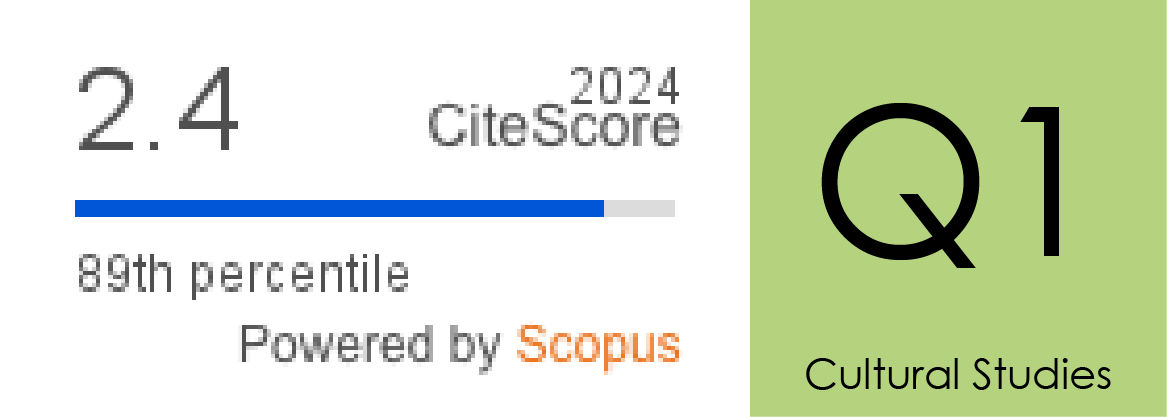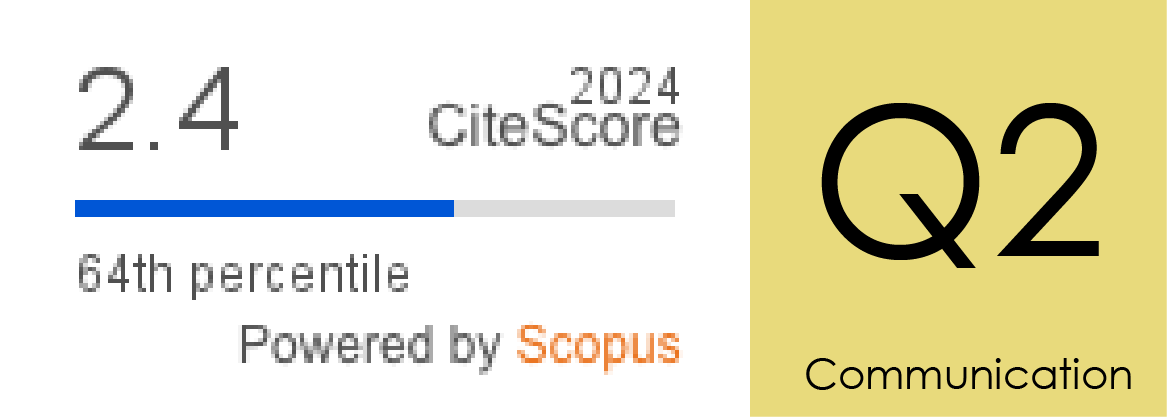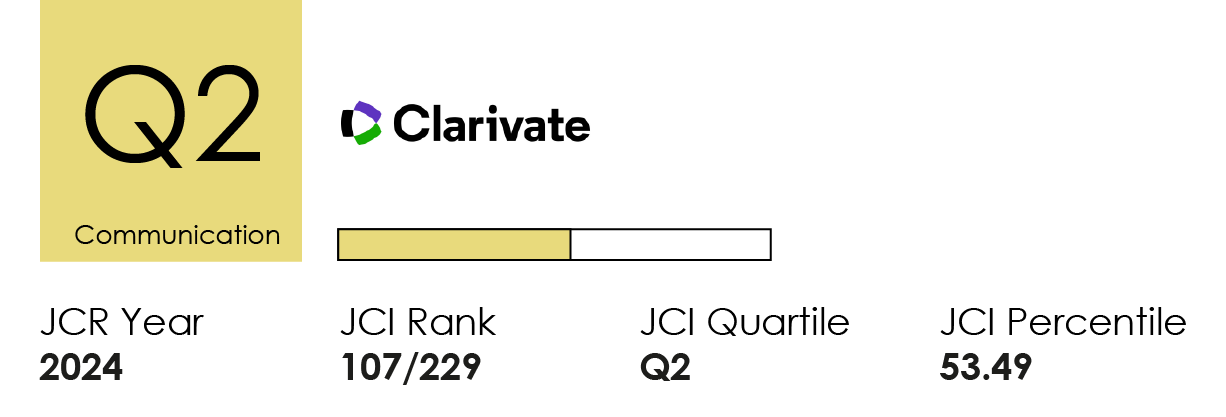La entrevista política ante el sesgo audiovisual. El caso de Los desayunos de TVE (2018)
DOI:
https://doi.org/10.14198/MEDCOM000008Palabras clave:
Comunicación audiovisual, comunicación política, realización televisiva, narrativa audiovisualResumen
En esta investigación se discute el posible sesgo en el desarrollo de las entrevistas televisivas a líderes políticos. Se considera que el proceso narrativo audiovisual y la puesta en escena, responsabilidad del equipo de realización, puede tener un papel decisivo en la neutralidad de las entrevistas. Se analiza el tratamiento audiovisual otorgado por la televisión pública española TVE durante el programa Los desayunos de TVE a los principales líderes políticos españoles, Pedro Sánchez, Pablo Iglesias, Albert Rivera y Mariano Rajoy y a sus colaboradores más cercanos, Adriana Lastra, Pablo Echenique, Fernando de Páramo y Fernando Martínez-Maillo, durante 2018. Durante las entrevistas analizadas se han descubierto narrativas audiovisuales dirigidas desde el equipo de realización del programa capaces de condicionar la imparcialidad de la entrevista. Se discute si el tratamiento audiovisual otorgado a cada uno de los líderes políticos es homogéneo, siendo las localizaciones y escenografías similares. Los resultados evidencian que los distintos líderes políticos no han tenido las mismas condiciones o tratamiento narrativo en la realización audiovisual, por lo que no se han enfrentado a las mismas amenazas implícitas en las preguntas que componen las entrevistas analizadas.
Financiación
Ministerio de Economía y Competitividad (CSO2016- 77331-C2-1-R)Citas
Amiel, V. (2005). Estética del montaje. Madrid: Abada.
Angus, D.; Fitzgerald, R.; Atay, C. & Wiles, J. (2016). Using visual text analytics to examine broadcast interviewing. Discourse, Context y Media, 11, 38-49. http://doi.org/dz68
Angus, D.; Rintel, S. & Wiles, J. (2013). Making sense of big text: a visual-first approach for analysing text data using Leximancer and Discursis. International Journal of Social Research Methodology, 16(3), 261-267. http://doi.org/dz69
Atkinson, M. D.; Enos, R. D. y Hill, S. J. (2009). Candidate Faces and Election Outcomes. Quarterly Journal of Political Science, 4(3), 229–49. http://doi.org/bwp355
Balàzs, B. (1987). El Film: evolución y esencia de un arte nuevo. Barcelona: Gustavo Gili.
Banducci, S. A.; Karp, J. A.; Thrasher, M. & Rallings, C. (2008). Ballot Photographs a Cues in Low-Information Elections. Political Psychology, 29(6), 903–17. http://doi.org/bxdd2g
Baum, M.A. & Groeling, T., (2008). New media and the polarization of American political discourse. Political Communication, 25, 345--365. http://doi.org/c2nndq
Baum, M.A. & Jamison, A.S. (2006). The Oprah effect: how soft news helps inattentive citizens vote consistently. The Journal of Politics, 68, 946--959. http://doi.org/dv3w5t
Bavelas, J. B.; Black, A.; Bryson, L. & Mullett, J. (1988). Political equivocation: A situational explanation. Journal of Language and Social Psychology, 7, 137–145. http://doi.org/fhzgrb
Bavelas, J. B.; Black, A.; Chovil, N. & Mullet, J. (1990). Equivocal Communication. Newbury Park: Sage.
Bell, P. & Van Leeuwen, T. (1994). The Media Interview: Confession, Contest, Conversation. Kensington, Australia: UNSW Press.
Berggren, N.; Henrik Jordahl, H. & Poutvaara, P. (2010). The Looks of a Winner: Beauty and Electoral Success. Journal of Public Economics, 94(1–2), 8–15. http://doi.org/b2r9s7
Brown, P. & Levinson, S. C. (1978). Universals in language usage: Politeness phenomena. In Questions and politeness: Strategies in social interaction (pp. 56-311). Cambridge University Press. https://bit.ly/31c7Qhc
Bull, P. (1994). On identifying questions, replies, and non-replies in political interview. Journal of Language and Social Psychology, 13, 115–131. http://doi.org/cnqqt6
Bull, P. (2000). Equivocation and the rhetoric of modernization: An analysis of televised interviews with Tony Blair in the 1997 British General Election. Journal of Language and Social Psychology, 19(2), 222-247. http://doi.org/b8vvsf
Bull, P. (2002). Communication under the microscope: The theory and the practice of microanalysis. London: Routledge. http://doi.org/fh5m49
Bull, P. & Mayer, K. (1993). How not to answer questions in political interviews. Political Psychology, 14(4), 651-666. http://doi.org/drsf8h
Bull, P. & Elliott, J. (1998). Level of threat: Means of assessing interviewer toughness and neutrality. Journal of Language and Social Psychology, 17, 220–244. http://doi.org/dwnm7b
Bull, P.; Elliott, J.; Palmer, D. & Walker, L. (1996). Why politicians are three-faced: The face model of political interviews. British Journal of Social Psychology, 35, 267–284. http://doi.org/bpkpn3
Clayman, S. E. (1993). Reformulating the question: a device for answering/not answering questions in news interviews and press conferences’. Text, 13, 159-1 88. http://doi.org/d2dhkc
Clayman, S. E. (2001). Answers and evasions. Language in society, 30(3), 403-442. http://doi.org/ggxmht
Clayman, S. E.; Elliott, M. N.; Heritage, J. & McDonald, L. L. (2006). Historical trends in questioning presidents, 1953-2000. Presidential Studies Quarterly, 36(4), 561-583. http://doi.org/d2dhkc
Clayman, S. & Heritage, J., (2002). The News Interview: Journalists and Public Figures on the Air. Cambridge: Cambridge University Press. http://doi.org/fg3xbd
Clayman, S. E. & Whalen, J. (1989). When the medium becomes the message: the case of the Rather-Bush encounter. Research on Language and Social Interaction, 22, 241–272. http://doi.org/bqmvnz
Coe, K.; Kenski, K. & Rains, S. (2014). Online and uncivil? Patterns and determinants of incivility in newspaper website commentary. Journal of Communication, 64, 658-679. http://doi.org/f6dxrx
Cruttenden, A. (1986). Intonation. New York: Cambridge University Press.
Day, R. (1961). Television: A Personal Report. London: Hutchinson.
Dimitrova, D.V. & Strömbäck, J. (2012). Election news in Sweden and the United States: a comparative study of sources and media frames. Journalism, 13, 604-619. http://doi.org/fzs7mj
Ekström, M. (2001). Politicians interviewed on television news. Discourse y Society, 12(5), 563-584. http://doi.org/fvvh94
Ekström, M. & Kroon Lundell, Å. (2011). Beyond the broadcast interview: Specialized forms of interviewing in the making of television news. Journalism Studies, 12(2), 172-187. http://doi.org/bgzj9g
Elliott, J. & Bull, P. (1996). A question of threat: face threats in questions posed during televised political interviews. Journal of community y applied social psychology, 6(1), 49-72. http://doi.org/dztcdr
Emmertsen, S. (2007). Interviewers’ challenging questions in British debate interviews. Journal of Pragmatics, 39(3), 570-591. http://doi.org/btq6t8
Feldman, O. & Kinoshita, K. (2019). Ignoring Respect: The Effects of Threat to Face on Replies and the Ensuing Questions During Broadcast Political Interviews in Japan. Journal of Language and Social Psychology, 38(5-6), 606-627. http://doi.org/dz7b
Feldman, O.; Kinoshita, K. & Bull, P. (2015). Culture or communicative conflict? The analysis of equivocation in broadcast Japanese political interviews. Journal of Language and Social Psychology, 34, 65-68. http://doi.org/f6rmf6
Feldman, O.; Kinoshita, K. & Bull, P. (2016). Ducking and diving: How political issues affect equivocation in Japanese political interviews. Japanese Journal of Political Science, 17, 141-167. http://doi.org/dz7c
Feldman, O.; Kinoshita, K. & Bull, P. (2017). Failures in leadership: How and why wishy-washy politicians equivocate on Japanese political interviews. Journal of language and politics, 16(2), 285-312. http://doi.org/dz7d
Fetzer, A. & Weizman, E. (2006). Political discourse as mediated and public discourse. Journal of Pragmatics, 38(2), 143-153. http://doi.org/csqqbh
Garcés, P. (2010). A gender approach to the study of im-politeness. International Review of Pragmatics, (2), 46-94. http://doi.org/dcbtr5
Gnisci, A. (2008). Coercive and Face‐Threatening Questions to Left‐Wing and Right‐Wing Politicians During Two Italian Broadcasts: Conversational Indexes of Par Conditio for Democracy Systems. Journal of Applied Social Psychology, 38(5), 1179-1210. http://doi.org/d5xmp8
Gnisci, A.; Di Conza, A. & Zollo, P. (2011). Political journalism as a democracy watchman. In P. Herrmann (Ed.), Democracy in Theory and Action (pp. 205-230). New York: NOVA Publishers.
Gnisci, A.; Zollo, P.; Perugini, M. & Di Conza, A. (2013). A comparative study of toughness and neutrality in Italian and English political interviews. Journal of Pragmatics, 50(1), 152-167. http://doi.org/dz7f
Goffman, E. (1955). On face-work: an analysis of ritual elements in social interaction, Psychiatry, 18(3), 213-231. http://doi.org/gf89w7
Goffman, E. (1959). The Presentation of Selfin Everyday Life. New York: Anchor.
Graber, D. A. (1996). Say it with pictures. The annals of the American academy of political and social science, 546(1), 85-96. http://doi.org/c9qmkv
Graber, D. A. (2001). Processing Politics: Learning from Television in the Internet Age. Chicago: University of Chicago Press. http://doi.org/dz7g
Greatbatch, D. (1986). Aspects of Topical Organization in News Interviews: The Use of Agenda-Shifting Procedures by Interviewees. Media, Culture & Society, 8(4), 441–455. http://doi.org/b84h5h
Greatbatch, D. (1988). A turn-taking system for British news interviews. Language in society, 17(3), 401-430. http://doi.org/brvmt9
Hagerty, B. (2010). TV’s political host with the most. British Journalism Review, 21, 19-27. http://doi.org/dcbbnc
Hallin, D. & Mancini, P. (2004). Comparing Media Systems: Three Models of Media and Politics. Cambridge: Cambridge University Press. http://doi.org/drqwt4
Hallin, D.C. & Mancini, P. (Eds.) (2012). Comparing Media Systems Beyond the Western World. New York: Cambridge University Press. http://doi.org/ggk8kg
Hamilton, M. A. & Mineo, P. J. (1998). A framework for understanding equivocation. Journal of Language and Social Psychology, 17, 3–35. http://doi.org/bcbgxj
Heffelfinger, C. (2014). Cortesía y construcción de género en 10 entrevistas políticas de la televisión puertorriqueña. Diálogo de la Lengua, 6, 95-115. https://bit.ly/3fA8qdj
Heritage, J. C.; Clayman, S. E. & Zimmerman, D. (1988). Discourse and message analysis: the micro-structure of mass media messages. In R. Hawkins; S. Pingree & J. Weinmann (Eds.), Advancing Communication Science: Merging Mass and Interpersonal Processes (pp. 77-109). Newbury Park: Sage.
Heritage, J. (1985). Analysing news interview: aspects of the production of talk for an overhearing audience. In T. Van Dijk (Ed.), Handbook of Discourse Analysis. London: Academic Press.
Heritage, J. & Greatbatch, D. (1991). On the institutional character of institutional talk: The case of news interviews. In D. Boden & D. Zimmerman (Eds.), Talk and social structure (pp. 93-137). Cambridge, England: Polity Press.
Higgins, M. (2010). The public inquisitor as media celebrity. Cultural Politics, 6, 93-110. http://doi.org/dghr39
Hopmann, D.N.; Van Aelst, P. & Legnante, G., (2012). Political balance in the news: a review of concepts, operationalizations and key findings. Journalism, 13, 240-257. http://doi.org/cj34gk
Huls, E. & Varwijk, J. (2011). Political bias in TV interviews. Discourse y Society, 22(1), 48-65. http://doi.org/cb2ztp
Hutchby, I. (2006). Media Talk-Conversation Analysis and the Study of Broadcasting. Berkshire, England: Open University Press.
Iyengar, S.; Peters, M. & Kinder, D. (1982). Experimental Demonstrations of the ‘Not-So Minimal’ Consequences of Television News Programs. American Political Science Review, 76(4), 848–58. http://doi.org/dz7h
Jucker, J. (1986). News Interviews: a Pragmalinguistic Analysis. Amsterdam: Gieben. http://doi.org/dz7j
King, A. & Leigh, A. (2009). Beautiful Politicians. Kyklos, 62(4), 579–93. http://doi.org/bk4krc
Kinnear, P.R. & Gray, C.D. (2001). SPSS for Windows Made Simple, Release 10. Hove: Psychology Press.
Landis, J. R. & Koch, G. G. (1977). An application of hierarchical kappa-type statistics in the assessment of majority agreement among multiple observers. Biometrics, 33(2), 363-374. http://doi.org/cgxczv
Lawson, C.; Lenz, G.; Myers, M. & Baker, A. (2010). Candidate Appearance, Electability, and Political Institutions: Findings from Two Studies of Candidate Appearance. World Politics, 62(4), 561–93. http://doi.org/fn6sxf
Lengauer, G.; Esser, F. & Berganza, R. (2012). Negativity in political news: a review of concepts, operationalizations and key findings. Journalism, 13, 179-202. http://doi.org/c2jp84
Lenz, G. S. & Lawson, C. (2011). Looking the part: Television leads less informed citizens to vote based on candidates’ appearance. American Journal of Political Science, 55(3), 574-589. http://doi.org/dks2z7
Lewin, K. (1938). The conceptual representation and measurement of psychological forces. Durham, NC: Duke University Press. http://doi.org/bnf755
Liebes, T. (2001). Look me straight in the eye: the political discourse of authenticity, spontaneity and sincerity. The Communication Review, 4, 499-510. http://doi.org/cmx9j7
Martín, M. (1999). El Lenguaje del cine. Barcelona: Gedisa.
McCombs, M. E. & Mauro, J. B. (1988). Predicting newspaper readership from content characteristics’, Newspaper Research Journal, 10(1), 2530. http://doi.org/dz7k
McNair, B., (2000). Journalism and democracy: a millennium audit. Journalism Studies 1, 197-211. http://doi.org/cqj89j
McQuail, D. (1992). Media Performance. London: Sage.
Mead, G. H. (1934). Mind, Selfand Society. Chicago: University Press.
Mendelberg, T. (2001). Playing the Race Card: Campaign Strategy, Implicit Messages, and the Norm of Equality. Princeton, NJ: Princeton University Press. http://doi.org/dz7m
Mickelson, S. (1976). The Candidate in the Living Room. The Annals of the American Academy of Political and Social Science, 427(1), 23–32. http://doi.org/bxc73z
Mitry, J. (2002). Estética y psicología del cine. Barcelona, Siglo XXI.
Montgomery, M. (2008). The discourse of the broadcast news interview: A typology. Journalism Studies, 9(2), 260-277. http://doi.org/czpdx4
Morales, F. (2011). Diseño de un modelo de construcción informativa audiovisual eficiente: una propuesta para la generación de efectos de sentido. E-Compós, 14(1). http://doi.org/dz7n
Neuendorf, K. A. (2016). The content analysis guidebook. Sage. http://doi.org/dz7p
Nimmo, D. D. & Combs, J. E. (1985). Nightly Horrors: Crisis Coverage by Television Network News. TN: University of Tennessee Press.
Papacharissi, Z. (2004). Democracy online: Civility, politeness, and the democratic potential of online political discussion groups. New Media and Society, 6, 259-283. http://doi.org/dz4rp6
Pomerantz, A. (1984). Pursuing a Response. In J. Atkinson & J. Heritage (Eds.), Structures of Social Action: Studies in Conversation Analysis (pp. 152–63). Cambridge: Cambridge University Press.
Sacks, H. (1992). Lectures on Conversation. Malden, MA: Black well Publishing.
Sacks, H.; Schlegloff, E. & Jefferson, G. (1974). A simplest systematics for the organization of turn-taking for conversation. In J. Schenkein (Ed.), Studies in the Organization of Conversational Interaction (pp. 7-55). Elsevier. http://doi.org/dz7q
Saperas, E. (2009). Los efectos cognitivos de la comunicación de masas: las recientes investigaciones en torno a los efectos de la comunicación de masas: 1970-1986. Barcelona: Ariel.
Scannell, P. (1996). Radio Television and Modern Life. Oxford: Blackwell.
Schudson, M. (1994). Question Authority: A History of the News Interview in American Periodism, 1860 – 1930. Media, Culture y Society, 16, 565–87. http://doi.org/dz7r
Strömbäck, J. & Shehata, A., (2007). Structural biases in British and Swedish election news coverage. Journalism Studies, 8, 800-810. http://doi.org/djkqfj
Stryker, R.; Conway, B.A. & Danielson, T. (2016). What is political incivility? Communication Monograph, 83, 535-556. http://doi.org/dz7s
Tabachnick, B. G.; Fidell, L. S. & Ullman, J. B. (2007). Using multivariate statistics. Boston, MA: Pearson.
Taboada, M. & Mann, W. (2005). Rhetorical structure theory: looking back and moving ahead. Discourse Studies, 8(3), 423-459. http://doi.org/cs325m
Tannen, D. (1998). The Argument Culture: Changing the Way we Argue. New York: Virago Press.
Tolson, A. (2006). Media Talk-Spoken Discourse on TV and Radio. Edinburgh: Edinburgh University Press.
Waver, D.H. & Wilnatt, L. (Eds.) (2012). The global journalist in the 21th century. London: Routledge. http://doi.org/f3rrgj
Descargas
Estadísticas
Publicado
Cómo citar
Número
Sección
Licencia
Derechos de autor 2021 Sebastián Sánchez-Castillo, Esteban Galán-Cubillo, Arnau Gifreu-Castells

Esta obra está bajo una licencia internacional Creative Commons Atribución-CompartirIgual 4.0.
Los autores y autoras que publican en esta revista están de acuerdo con los siguientes términos:
1 Derechos de autor. Los autores y autoras conservan sus derechos de autor, aunque ceden a la revista de forma no exclusiva los derechos de explotación (reproducción, distribución, comunicación pública y transformación) y garantizan a esta el derecho de primera publicación de su trabajo, el cual estará simultáneamente sujeto a la licencia indicada en punto 2. Los autores pueden establecer otros acuerdos adicionales para la distribución no exclusiva de la versión de la obra publicada en la revista, siempre que exista un reconocimiento de su publicación inicial en esta revista.
© Los autores.
2 Licencia. Los trabajos se publican en la revista sujetos a la licencia de Reconocimiento 4.0 Internacional de Creative Commons (CC BY 4.0); los términos se pueden consultar en https://creativecommons.org/licenses/by/4.0/
Esta licencia permite a terceros compartir (copiar y redistribuir el material en cualquier medio o formato) y adaptar (remezclar, transformar y crear a partir del material para cualquier finalidad, incluso comercial), siempre que se reconozca la autoría y la primera publicación en esta revista (Revista Mediterránea de Comunicación (RMC) / Mediterranean Journal of Communication (MJC), Universidad de Alicante, DOI de la obra), se proporcione un enlace a la licencia y se indique si se han realizado cambios en la obra.
3 Política de autoarchivo. Se recomienda a los autores que difundan sus trabajos a través de Internet para favorecer una circulación y difusión más rápidas y, con ello, un posible aumento en la citación y alcance entre la comunidad científica y académica, en las siguientes condiciones:
No se permite a los autores depositar en un repositorio institucional o temático, página web propia, etc., las versiones preprint (versión antes de ser evaluada) o postprint (versión evaluada y aceptada para su publicación) de sus trabajos antes de su publicación, pero sí el artículo final publicado (versión del editor).













